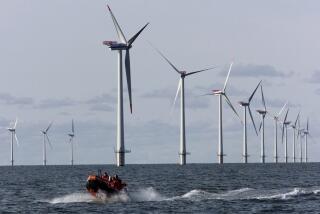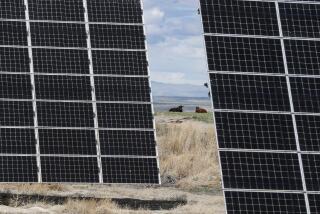Winds of Change Are Coming to Britain’s Power Industry : Technology: The generation of electricity using wind turbines has attracted numerous boosters. There are high hopes for government subsidies.
- Share via
CARMARTHEN BAY, Wales — On a wind-swept field overlooking the sea, workers are demolishing a huge coal-fired power plant while nearby, four sleek wind turbines harvest energy from the air.
It looks like a straightforward transition from the old to the new, but in this traditional coal mining area of southern Wales the reality is not so simple.
It is true that coal-fired power plants are being phased out as mines run short of reserves. The wind turbines are just an experiment, more a tourist attraction than a significant energy resource.
Wind turbines--the most viable form of large-scale alternative energy now available--already produce substantial amounts of electricity in California and Denmark, which pioneered research in response to soaring oil prices in the 1970s.
Many other countries have toyed with wind energy for years, but only now is it becoming a commercial reality--especially with the Persian Gulf War highlighting the dangers of relying on oil and a new emphasis on the environmental damage caused by burning fossil fuels.
Work is expected to start soon on Britain’s first commercial wind farm.
Even the most cautious studies show that wind could provide at least 2% of Britain’s energy needs, saving the atmosphere from 5 million tons of polluting gases.
Manufacturers hope the British initiative will give the industry the breakthrough it needs. According to Lyn Harrison, editor of the international magazine Windpower Monthly, Britain has “more experts per megawatt than anywhere else.”
One of them is Simon Powles, who collects data and fields visitors’ questions at the Carmarthen Bay demonstration center.
He said wind power took a long time to get going because people were not sufficiently environmentally aware, or--as Europeans say--”green” enough.
“The man in the street is light green--broadly in favor of recycling but not wishing to make any sacrifices,” Powles said. “There are very few hard green people.”
Ironically, one of the sacrifices to be made is environmental. Wind turbines may not pollute the atmosphere, but many of the early models erected in California were ugly and noisy--and dangerous.
That has changed.
Turbines are now streamlined, make no more noise than the wind itself and--as Powles assures the nervous visitor--the large whirring blades are safe.
With diameters of up to 100 feet, they are still hard to hide. A wind farm can occupy hundreds of square miles, although enthusiasts are quick to point out that regular farming can continue among turbines.
“The local authority had reservations about the wind farm in Cornwall, but they changed their minds once they’d been shipped over to Denmark to see one for themselves,” said Nicholas Hallstride, government project officer for wind energy.
The other problem with wind energy is cost.
This has dropped by more than half since the first turbines were set up in the United States and a kilowatt-hour of wind-powered electricity now costs less than half that for nuclear energy and about 20% less than solar energy.
But costs are still prohibitive. Hallstride said that wind power succeeded in California and Denmark only because it was given substantial government funding.
In California, the initial rush to establish turbines subsided once tax incentives were withdrawn.
Such funding never materialized in Britain, partly because at the time the country exported fuel from its North Sea oil field.
“The fact is that no new coal-fired stations have been built in the last 10 years. But everyone’s taking the short-term view and going over to (natural) gas,” said Hallstride, who believes Britain’s North Sea gas will not stay at current low prices.
Wind power also has to compete for funds with the nuclear industry. In 1989-90, the government planned to spend about $240 million on nuclear research and development, and only $10 million on the development of wind power.
While Denmark and, more recently, Sweden have decided to abandon nuclear power in favor of wind energy, Powles said new measures introduced in Britain to encourage the use of non-fossil fuels are biased in favor of nuclear power.
“The subsidy (for non-fossil fuels) will be chopped in 1998. This is a major sticking point,” he said, explaining that the pay-back period on a wind turbine is 15 years.
Manufacturers are looking to the European Community to provide the long-term incentives, both financial and legislative, for wind energy development.
Grants are available, and Ireland hopes to prove how these can make wind power commercially viable by offering sites to bidders with no state funding.
Peter Musgrove, deputy managing director of Wind Energy Group, which, with the aid of the non-fossil fuel and EC subsidies, will build Britain’s first wind farm, is confident that the EC will give wind energy a vital boost by introducing a tax on fossil fuels within the next three years.
Once people get used to seeing wind farms, he said, their objections to the wider use of wind energy will fall away.
“All we really need is an opportunity to get into production and show what wind energy can do,” Musgrove said.
More to Read
Inside the business of entertainment
The Wide Shot brings you news, analysis and insights on everything from streaming wars to production — and what it all means for the future.
You may occasionally receive promotional content from the Los Angeles Times.










